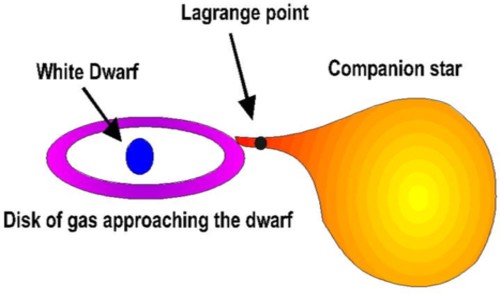THE SPECTRA OF NOVAE AND SUPERNOVAE
Introduction
- V838 Mon
- V4743 Sgr
- V2362 Cyg
Novae
A naked eye nova appears each ten years or so, but those that are brighter than 10th
magnitude (and thus are suited for amateur spectroscopy) are a couple per year.
During last century only Nova Persei in 1901, Nova Aquilae in 1918, Nova Herculis in 1934
and Nova Cygni in 1975 reached the first magnitude.
Since the spectroscopic observation of Nova T Aurigae in 1892, a nova has been considered
as a stellar explosion (that increase up to 10 mag in one day the brightenss of the star).
But it was only in 1954 that Merle F. Walker discovered that the nova Herculis was a
close bynary system and make the hypothesis, since then widely accepted, that all the
novae are close binaries.

|
|
Picture 1: Drawing of a nova.
|
One of the two stars is a white dwarf (see picture 1). The tidal attraction of the white
dwarf change the shape of the companion star until when mass can be loss throught the
Lagrangian point.
The gas rotate around the dwarf closer and closer until when it falls onto the degenerate
surface starting a nuclear reactions that brings to the explosion of the outer shell of
the dwarf.
The gas is then ejected at high speed (2000 to 5000 Km/sec, typically) and when the
expanding gas cools down to 10000 K it shows strong lines of Iron and sometimes Neon at
high ionisation in addition to He and Hydrogen.
In the following "nebular" phase appear the forbidden Oxygen and Nitrogen lines that can
be observed also in diffuse emission nebulae like M42.
For classical novae the explosions can repeat after centuries.
The ejected gas mass is of the order of 1/100'000 solar masses.
The evolution speed of a nova is a function of the mass of the white dwarf. A massive
dwarf (type ONeMg) will create a stronger explosion and thus a faster evolution of
the ejected shell than for a smaller white dwarf (type CO).
In general, all the evolution of a nova eruption depends upon the mass and type of the
two companion (even if the details are still not well understood) and a great variety
of spectra can be generated from case to case. This is perhaps the biggest interest
in the study of novae.
In addition to classical novae, in the sky we can find a lot of stars that more or less
periodically have outburst whose mechanism is related with that of classical novae
altought with shorter periods and reduced brightness. The prototype of this variable
stars class is Z Camelopardalis that climb up 2 to 6 mag every 10-50 days.
Goto the spectra of Novae or SuperNovae :
V838 Mon
- V4743 Sgr
|

